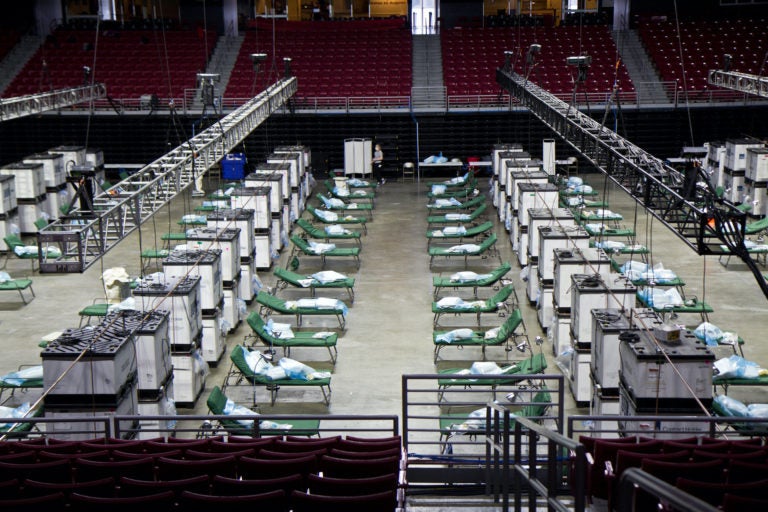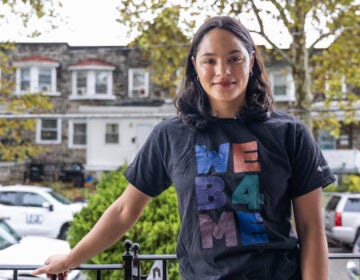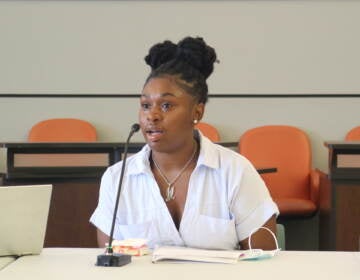Philly spends $5 million on coronavirus surge hospital that admitted 14 patients
Not eligible for insurance, the city hopes to be reimbursed by the feds for the Liacouras Center overflow site.

Temple University’s Liacouras Center. (Kimberly Paynter/WHYY)
At Temple University’s Liacouras Center, most of the 200 hospital beds sat empty for the facility’s two weeks in operation.
The surge of coronavirus patients never came.
Philadelphia’s “COVID-19 Surge Facility” admitted just 14 patients since it opened to the public on April 16, Mayor Jim Kenney’s administration confirmed Monday. That’s about a quarter of the 58 referrals the city received from hospitals looking to free up precious bed space and transfer patients to the city-run site.
Last week, as he announced plans to wind down the surge facility, Kenney said “better to build it and they don’t come than to not build it at all.” In other words: better safe than sorry.
“With 1.6 million citizens in the city, this is a $4 investment of city tax dollars per citizen — an investment surely worth the safety of our citizens,” Kenney spokesperson Deana Gamble said Monday.
Setting up and running the facility for the month of April cost the city $4 million. That figure is expected to rise to $5.2 million by the end of May, as officials maintain bare-bones operations at the North Broad Street facility in the event of a late surge.
The estimated bill has financed staffing, patient care and the one-time cost of converting the North Broad Street events complex into a makeshift field hospital, replete with emergency generators and oxygen masks. It will also include restoring the facility back to its original state before handing the keys back to the university, Gamble said.
The city expects to be reimbursed in large part for the up front expenses by the federal government.
Surge hospitals go unused nationwide
Philadelphia isn’t alone in seeing its pop-up pandemic hospital go unused.
Temporary hospitals set up in three of Ohio’s largest cities have also sat vacant, and current data modelling suggests they won’t be needed. Ditto for surge sites in California, Michigan and Oklahoma.
In New York City, while many hospital ICUs were near or over capacity, a hospital ship docked at the city’s shores to provide support, and the Javits Center was set up to hold 1,000 patients each. Both sat mostly empty as sick patients overwhelmed hospitals.
The Liacouras Center facility was designed to take COVID-19 patients who were stable enough to leave the hospital but not well enough to go home, as a way to free up space in the hospital ICUs.
While hospitals in Pennsylvania never reached capacity, many regional hospitals reported backlogs in discharging patients who fit the profile described for the Liacouras. Nursing homes, whose residents are among the city’s most vulnerable, began admitting COVID-19 patients as a way of freeing up space in hospitals. Still, the city’s field hospital remained empty.
Part of the disconnect may have been at the hospital level. Just days before it opened, top doctors at Temple University Hospital’s COVID-19 unit expressed confusion about which patients Liacouras was supposed to admit.
Hospitals could have also been reluctant to send patients elsewhere for financial reasons, said Dr. Lisa Bielamowicz, co-founder of Gist Healthcare, a consulting service for health systems.
“With tons of physician visits and elective procedures cancelled, they don’t want to turn away patients if they have staff and capacity,” Bielamowicz said.
Because the Liacouras Center isn’t a licensed hospital, it can’t bill insurance companies for patients’ treatment.
Gamble said the city health department and the Office of Emergency Management will seek reimbursement from any federal and state funding sources, under pandemic disaster declarations. In its latest guidelines, the Centers for Medicare and Medicaid Services does allow for makeshift hospitals to receive public insurance reimbursements.
Most patients referred to Liacouras never got there
Eight of the 14 admitted patients did not have insurance.
Health officials nationwide, bracing for hospital wards to overflow with COVID-19 patients as they have in other countries, largely agree the preventative measures were worth the cost. They also warn of potential new surges as many states rush to re-open.
In a widely lauded move, Temple offered its 10,000-seat sports arena to the city at no cost after negotiations over the former Hahnemann Hospital building fizzled out.
But the writing was on the wall early. On its first day open at the Liacouras site, hospitals didn’t refer a single patient to the site. From there, it was a slow trickle at best.
Over the last two weeks, only one out of every four patients referred to the site ended up getting in.
Dozens of referrals came in from hospitals citywide — including Temple, Mercy Fitzgerald, Penn Presbyterian, and Chestnut Hill.
Of the 58 potential cases, about a quarter were discharged the same day that they were scheduled to move to COVID-19 Surge Facility. The city also turned away about one in three referrals for a range of reasons: unstable vital signs, they required a higher level of care than the Liacouras could provide, or in some cases, their COVID-19 test results came back negative.
Should the second wave come, officials say they’ll be ready.
Gamble said the last patient was discharged over the weekend, at which time “the facility was secured and remains in a ‘ready’ status to reopen should the city experience an unexpected surge in the coming weeks.”
WHYY is your source for fact-based, in-depth journalism and information. As a nonprofit organization, we rely on financial support from readers like you. Please give today.


![CoronavirusPandemic_1024x512[1]](https://whyy.org/wp-content/uploads/2020/03/CoronavirusPandemic_1024x5121-300x150.jpg)




